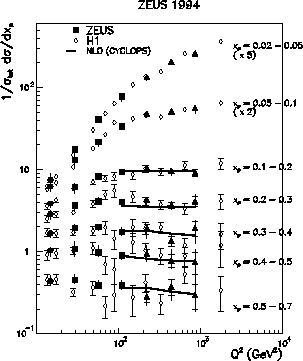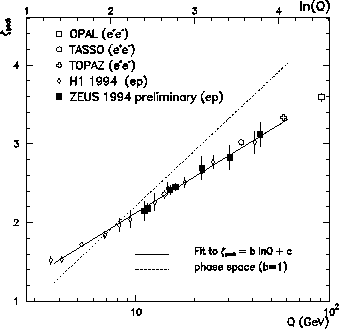In e+e- annihilation the two quarks are produced
with equal and opposite momenta, ![]() This can be compared with
a quark struck from within the
proton with outgoing momentum -Q/2 in the Breit frame.
In the direction of the struck quark (the current fragmentation region)
the particle momentum spectra, xp = 2pB/Q,
are expected to have a
dependence on Q similar to those observed in
e+e- annihilation [30,31,32] at energy
This can be compared with
a quark struck from within the
proton with outgoing momentum -Q/2 in the Breit frame.
In the direction of the struck quark (the current fragmentation region)
the particle momentum spectra, xp = 2pB/Q,
are expected to have a
dependence on Q similar to those observed in
e+e- annihilation [30,31,32] at energy ![]()
The inclusive charged particle distributions [33,34],
![]() are shown in figure 6
plotted in bins of
fixed xp as a function of Q2.
For
are shown in figure 6
plotted in bins of
fixed xp as a function of Q2.
For ![]() the distributions rise
with Q2 at low xp and
fall-off at high xp and high Q2.
By measuring the amount of
scaling violation one can ultimately
measure the amount of parton radiation and
thus determine
the distributions rise
with Q2 at low xp and
fall-off at high xp and high Q2.
By measuring the amount of
scaling violation one can ultimately
measure the amount of parton radiation and
thus determine ![]() Below
Below ![]() the fall off is due to depopulation of the
current region.
the fall off is due to depopulation of the
current region.
 |
The results can be compared to
the next-to-leading order (NLO)
QCD calculations, as implemented in CYCLOPS [35], of the charged
particle inclusive distributions
in the restricted region
![]() and
xp > 0.1 ,
where the theoretical uncertainties are small, unaffected by the
hadron mass effects which are not included in the fragmentation function.
This comparison is shown in figure 6.
The NLO calculation combines a full next-to-leading order matrix element
with the
and
xp > 0.1 ,
where the theoretical uncertainties are small, unaffected by the
hadron mass effects which are not included in the fragmentation function.
This comparison is shown in figure 6.
The NLO calculation combines a full next-to-leading order matrix element
with the
![]() parton densities (with a
parton densities (with a ![]() and NLO fragmentation functions
derived by
Binnewies et al. from fits to e+e- data [36].
The data and the NLO calculations are in good agreement,
supporting the idea of universality of quark fragmentation.
and NLO fragmentation functions
derived by
Binnewies et al. from fits to e+e- data [36].
The data and the NLO calculations are in good agreement,
supporting the idea of universality of quark fragmentation.
The peak position of the distributions, , was evaluated.
Figure 7 shows
the distribution of as a function of Q
for the HERA data [33,37,38]
and of ![]() for the e+e- data.
Over the range shown
the peak moves from
for the e+e- data.
Over the range shown
the peak moves from ![]() 1.5 to 3.0, equivalent to
the position of the maximum of the
corresponding momentum spectrum increasing from
1.5 to 3.0, equivalent to
the position of the maximum of the
corresponding momentum spectrum increasing from
![]() 400 to 900 MeV.
The HERA data points are
consistent with those from TASSO [39]
data and a clear agreement in the rate of
growth of the HERA points with
the e+e- data [39,40] is observed.
400 to 900 MeV.
The HERA data points are
consistent with those from TASSO [39]
data and a clear agreement in the rate of
growth of the HERA points with
the e+e- data [39,40] is observed.
 |
The increase of can be approximated phenomenologically
by the straight line fit
![]() also shown in figure 7.
Also shown is the statistical fit to the data
when b=1 which would be the case if the QCD
cascade
was of an incoherent nature, dominated by cylindrical phase space. (A
discussion of phase space effects is given in [41].)
In such a case, the logarithmic particle momentum spectrum would be
peaked at a constant value of momentum, independent of Q.
The observed gradient is clearly inconsistent with b=1
and therefore inconsistent with cylindrical phase space thus
supporting the coherent nature of gluon radiation.
also shown in figure 7.
Also shown is the statistical fit to the data
when b=1 which would be the case if the QCD
cascade
was of an incoherent nature, dominated by cylindrical phase space. (A
discussion of phase space effects is given in [41].)
In such a case, the logarithmic particle momentum spectrum would be
peaked at a constant value of momentum, independent of Q.
The observed gradient is clearly inconsistent with b=1
and therefore inconsistent with cylindrical phase space thus
supporting the coherent nature of gluon radiation.
latex2html conversion by www person on 1997-10-22